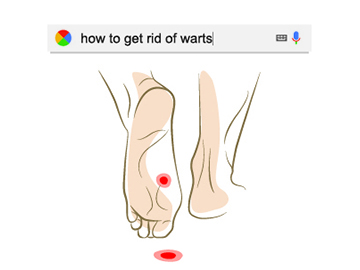
What is Autoimmune Therapy (also known as Needling Warts)?
The terms autoimmune therapy and needling warts refer to the same process, which essentially involves depositing a small amount of the wart virus into the deeper layers of your foot's dermis. This technique is similar to the way some vaccine works, by introducing a small amount of the wart virus into the deeper tissue, which causes an immune reaction, which in turn will cause the immune system to fight off the virus that caused the warts in the first place. Once your immune system has been activated, it generally takes between four and six weeks for the virus to be completely eradicated. What is interesting about this procedure, is that if the patient has multiple warts, even if they are on the other foot, the immune system will frequently resolve these areas as well. Autoimmune therapy works well when there is one primary wart (10 mm in diameter or larger) and multiple satellite warts. This treatment only needs to target the primary wart, and the immune system will deal with both the primary site and satellite lesions. This procedure takes less than 10 minutes and is performed under local anesthesia. No special care is required, and there are no restrictions on the patient’s activities.
Why Are Plantar Warts So Hard to Get Rid Of ?
Plantar warts are viruses and as such are not technically alive. A virus is more akin to a software program than to a living cell. In fact all viruses require a living cell in order to activate themselves. Viruses are tissue specific, meaning that a planter wart can only infect skin or mucosal cells. Plantar warts are tenacious infections because of the tissue that is involved….namely skin cells. Skin cells are unique in that they have the ability to regenerate. (Only liver cells and skin cells have this unique ability.) When the virus infects the skin cell, it gains the ability to regenerate. If you burn the skin with Compound W, or with a laser, or with some other method, the skin will recover, and not only repair itself, but also repair the damaged virus. It is this regenerative capability that makes plantar warts so difficult to treat.
Plantar Warts Are Common. Here's Why
Plantar warts, known as plantar (referring to bottom) verruca, are caused by a DNA virus - human papillomavirus (which is commonly referred to as HPV). There are at least 100 different strains of HPV, of which approximately 10 are most frequently the cause of plantar warts. Here are some common potential causes of plantar warts.
Walking barefoot in communal areas
Warts can spread from one person to another very easily and a common way that this transpires is by walking barefoot in communal and wet areas. This can include public showers, locker room floors and on pool decks. Always wear flip flops in these areas to protect yourself.
Not wearing socks
HPV loves warm and moist areas. When you're sweating and wearing shoes without socks, your skin is weakened/damaged from the moisture and friction. This allows the virus to enter the epidermis.
Sharing shoes
HPV and fungi that causes athlete’s foot, are often found in shoes. The verruca virus can transfer to you if you wear your friend's shoes, especially if you're not wearing socks. Keep this in mind when trying shoes on at a store – always wear socks!
Exposed cuts on your feet
Since HPV enters through micro abrasions and scratches, it's important to cover any minor abrasions with a bandage as soon as possible. This is especially important if you have diabetes, a condition in which you may be more likely to experience cuts or wounds on your feet.
Symptoms of Plantar Warts
Now you know how to get (and avoid) plantar warts, but how do you know if you already have them? Here are some of the common symptoms of plantar warts:
- Pain or tenderness when walking, standing or exercising.
- A small, fleshy, and rough growth on the bottom of your foot. Typically, near the base of the toes, forefoot or the heel.
- Hard, thickened skin (callus) over a well-defined spot on the skin of your foot where the wart has grown inwards.
- Black pinpoints on your skin. These are sometimes called wart seeds, but they are actually thrombosed capillaries (small clotted blood vessels) and are always indicative of a plantar wart.
- A lesion that disturbs the normal lines and ridges in the skin of your foot, known as dermatoglyphs, is frequently an indication that the normal skin function has changed.
Autoimmune Therapy Works, But Prevention is the Best Treatment for Plantar Warts
Of course, prevention is the best treatment for any illness. To help ensure you don’t get plantar warts on your feet, always follow these preventative measures:
- Wear shoes or flip flops when using the shower and locker facilities at your gym.
- Love yoga? Make sure you wear flip flops to and from your mat, sanitize your mat after each use, and don't share your mat with friends.
- Wear socks with your shoes and allow your feet to dry after exercising or doing any physical activity.
- Don’t share shoes with your friends or anyone else.
- If you get a cut or scratch on your foot, use an antiseptic cream or ointment and cover it up immediately.
Talk to Your Chiropodist About Autoimmune Therapy
If you're worried that you may have plantar warts, it's important to speak to your chiropodist as soon as possible, especially because the warts will tend to spread onto other areas of your foot. The good news is that there are many different treatment options. If you think you have plantar warts and would like to have them removed, autoimmune therapy may be the right treatment option for you.
Contact the experienced chiropodists at Medical Foot Solutions today to find out if autoimmune therapy is right for you.

